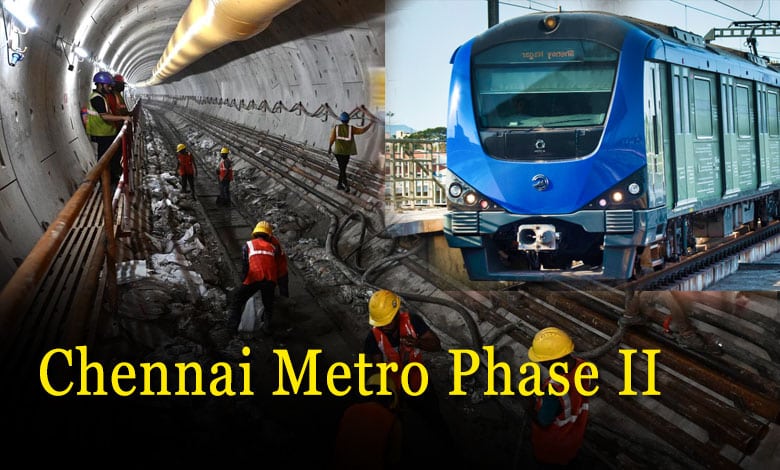Chennai Metro Phase II: CMRL Gears Up for Tunnelling Operations
Chennai Metro Phase II tunnelling work between Kolathur and Villivakkam to start soon. Discover the details, progress, and benefits of this ₹632 billion project.

Chennai: Chennai Metro Rail Limited (CMRL) is preparing to start tunnelling work for Chennai Metro Phase II between Kolathur and Villivakkam within the next two weeks.
This is a critical step in the city’s ₹632 billion ($7.6 billion) metro expansion project, designed to enhance Chennai’s public transport infrastructure.
The tunnelling process will be conducted using the Tunnel Boring Machine (TBM) ‘Kurinji’, which is already positioned at Kolathur. The underground stretch of this section will span five kilometres, with metro stations planned at Kolathur Junction, Srinivasa Nagar, Villivakkam Metro, Villivakkam Bus Terminus, and Villivakkam MTH Road.
Key Features of Chennai Metro Phase II
Three Corridors of Expansion
- Corridor 3: Madhavaram to SIPCOT
- Corridor 4: Light House to Poonamallee
- Corridor 5: Madhavaram to Sholinganallur
Focus on Corridor 5

- This key corridor will begin as an elevated stretch from Madhavaram to Retteri, transitioning to underground tunnels at Kolathur Junction and remaining so until Villivakkam MTH Road.
- After Villivakkam, the line will rise again and continue as an elevated track to Sholinganallur, passing through Madipakkam.
- The completion of this corridor will improve connectivity between key city areas and alleviate traffic congestion.
Enhanced Connectivity
- Once operational, Corridor 5 will link Kolathur and Villivakkam to major hubs such as Mylapore, Adyar, and the IT corridor along Old Mahabalipuram Road (OMR).
- Villivakkam will feature three metro stations, boosting accessibility and reducing travel time for commuters.
Progress and Challenges of the Project
Although Corridors 3 and 4 have progressed substantially, the underground portion of Corridor 5 has faced delays of over a year. However, CMRL officials remain optimistic about the tunnelling work, citing favorable soil conditions.
Soil Conditions
- The soil between Kolathur and Srinivasa Nagar consists primarily of clay, with some rocky patches near Srinivasa Nagar. These conditions are expected to make the excavation process smoother, reducing the chances of further delays.
Also Read: Telangana Southern Railways to Operate Special Trains During Weekends to Manage Extra Rush
Preparatory Work
- The TBM ‘Kurinji’ is set to begin tunnelling operations soon, with preparations currently underway. Once tunnelling is completed, further work on Phase II can proceed, bringing Chennai closer to completing the metro expansion.
Benefits of Chennai Metro Phase II

- Improved Public Transport: The new metro line will provide a faster, safer, and more efficient mode of transportation, helping ease the burden of Chennai’s traffic congestion.
- Reduced Traffic Congestion: The metro system will provide a reliable alternative to road transport, potentially easing traffic jams across the city.
- Economic Growth: Enhanced connectivity, particularly in commercial hubs like the IT corridor, is expected to boost economic activity and improve overall development in the city.
What’s Next for Chennai Metro Phase II?
The tunnelling work between Kolathur and Villivakkam is expected to take several months. Upon completion, it will pave the way for the further development of Chennai Metro Phase II, eventually creating a comprehensive metro network that will serve the entire city.

